As an Amazon Associate I earn from qualifying purchases.
In the diverse realm of nutrition, carbohydrates stand as one of the most discussed and, often, contentious topics. They are omnipresent, gracing our plates in the form of succulent fruits, wholesome grains, and sometimes, the irresistible but notorious sugary desserts. Carbohydrates are intrinsic to our dietary patterns, cultural cuisines, and everyday food choices. However, they are often enveloped in a cloud of misconception and oversimplification, painted with a broad brush that scarcely does justice to their complexity and multifaceted roles in health and disease.
Carbohydrates are organic compounds composed of carbon, hydrogen, and oxygen, primarily serving as energy-providing nutrients. They come in various forms—simple sugars that offer the swift surge of energy, complex starches that provide a sustained release of glucose, and fibers that cater to gut health and metabolic regulation. Each type holds a distinct role, interacting with bodily systems in unique ways that contribute to our overall well-being, or, when imbalanced, to health challenges.
The contemporary dietary landscape sees an oscillation between the vilification and glorification of carbohydrates. On one end of the spectrum, low-carb diets, epitomized by the ketogenic and paleo paradigms, have gained staunch adherents. These diets advocate for a minimal intake of carbohydrates, emphasizing proteins and fats as primary macronutrients. On the opposite end, plant-based and Mediterranean diets, rich in fruits, vegetables, and whole grains, showcase the potential benefits of carbohydrate-rich, yet balanced, eating patterns.
In the ensuing sections, we aim to demystify carbohydrates, delving into their varied types, their metabolic pathways, and their impacts on health. We will explore the nutritional content and health implications of common carbohydrate sources, with a special focus on rice—a staple food that nourishes billions. From the genetic and agricultural innovations shaping rice cultivation to the cultural perspectives coloring its consumption, we endeavor to present a comprehensive view.
Join us in unraveling the intricate tapestry of carbohydrates. Discover their multifaceted roles, explore informed dietary choices, and glean insights into balancing these essential macronutrients for optimal health, vitality, and longevity. The journey to understanding carbohydrates is not just a venture into the world of nutrition, but also an exploration of global agricultural practices, environmental sustainability, and the unyielding march of food innovation in the 21st century.
Table of Contents
Carbohydrates
Carbohydrates are one of the three macronutrients in human nutrition, alongside proteins and fats. They are organic compounds made up of carbon, hydrogen, and oxygen atoms. Carbohydrates serve as a primary source of energy for the body’s functions and physical activities. They can be classified into three main types based on their complexity and the number of sugar units they contain:
1. Monosaccharides:
- Definition: These are the simplest form of carbohydrates, consisting of single sugar molecules.
- Examples: Glucose, fructose, and galactose.
- Sources: Fruits, honey, and milk.
2. Disaccharides:
- Definition: Formed when two monosaccharides combine.
- Examples: Sucrose (glucose + fructose), lactose (glucose + galactose), and maltose (glucose + glucose).
- Sources: Table sugar, milk, and malted foods.
3. Polysaccharides:
- Definition: Complex carbohydrates consisting of multiple sugar units bonded together.
- Examples: Starch, glycogen, and cellulose.
- Sources: Grains, legumes, and tubers for starch; human and animal liver and muscles for glycogen; plant cell walls for cellulose.
Roles of Carbohydrates:
- Energy Source: They provide a quick source of energy. Glucose, a monosaccharide, is the body’s preferred energy source.
- Energy Storage: In the form of glycogen stored in the liver and muscles.
- Structural Role: Cellulose and other complex carbs provide structural support in plants.
- Digestive Health: Certain carbohydrates, like dietary fibers, aid in digestion and promote gut health.
Glycemic Index:
- It measures how quickly a carbohydrate-containing food raises blood glucose levels. Foods with higher values are associated with a quicker increase in blood sugar levels.
In the context of a balanced diet, it’s essential to consider the types and quality of carbohydrates consumed. Whole, unprocessed carbs with dietary fibers, such as whole grains, fruits, and vegetables, are generally healthier options compared to refined and processed carbs like white bread, pastries, and sugary drinks.
Understanding the Basics of Carbohydrates
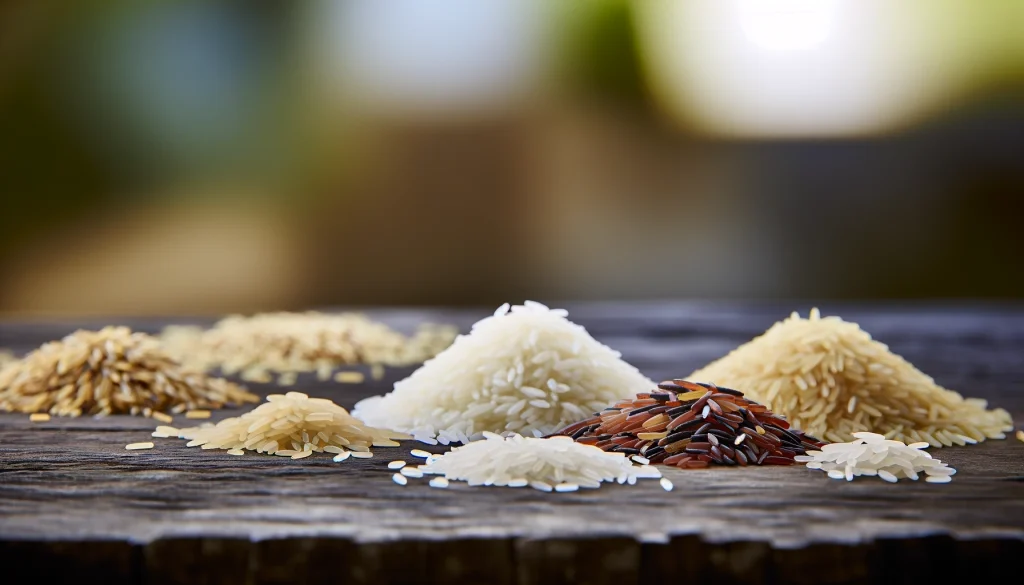
1. Chemical Composition
- Carbohydrates are composed of carbon (C), hydrogen (H), and oxygen (O) atoms. They often have a chemical formula of (CH2O)n, where ‘n’ is the number of carbon atoms.
- They are divided into three primary types: monosaccharides, disaccharides, and polysaccharides, depending on the number of sugar units present.
2. Types of Carbohydrates
- Monosaccharides: The simplest form of carbohydrates consisting of a single sugar molecule, such as glucose and fructose.
- Disaccharides: These contain two monosaccharide molecules, like sucrose (table sugar) and lactose (milk sugar).
- Polysaccharides: Complex carbohydrates with multiple sugar units, like starch in plants and glycogen in animals.
3. Energy Source
- Carbohydrates serve as a significant source of energy for our bodies. They are broken down into glucose in the bloodstream, providing fuel for cells, tissues, and organs.
- The brain, in particular, relies heavily on glucose as an energy source.
4. Dietary Fiber
- Fiber is a type of carbohydrate that the body cannot digest or absorb. It helps regulate the body’s sugar use, keeping hunger and blood sugar in check.
- Fibers are essential for digestive health, aiding in bowel movements and preventing constipation.
5. Glycemic Index (GI)
- The GI measures the impact of carbohydrate-containing foods on blood sugar levels. Foods with a low GI value are slowly digested and absorbed, causing a slower and smaller rise in blood sugar levels.
6. Balanced Diet
- Incorporating a balanced mix of carbohydrates is essential. Whole, unrefined carbs like whole grains, fruits, and vegetables are preferred for their nutrients and fibers.
- Limiting the intake of refined sugars and processed carbs can help manage weight and overall health.
7. Health Implications
- While carbs are essential, an imbalanced intake can lead to health issues like weight gain, type 2 diabetes, and other metabolic disorders.
- Complex carbs and high-fiber diets are associated with various health benefits, including reduced risk of chronic diseases.
8. Physical Performance
- Carbs play a crucial role in physical performance. They fuel muscles, support endurance, and aid in recovery post-exercise.
Understanding these basics provides a foundation to delve deeper into the role of carbohydrates in human health, their sources, and their implications in various diets and health conditions. This foundational knowledge is crucial for informed dietary choices and lifestyle adjustments.
The Role of Carbohydrates in Human Nutrition
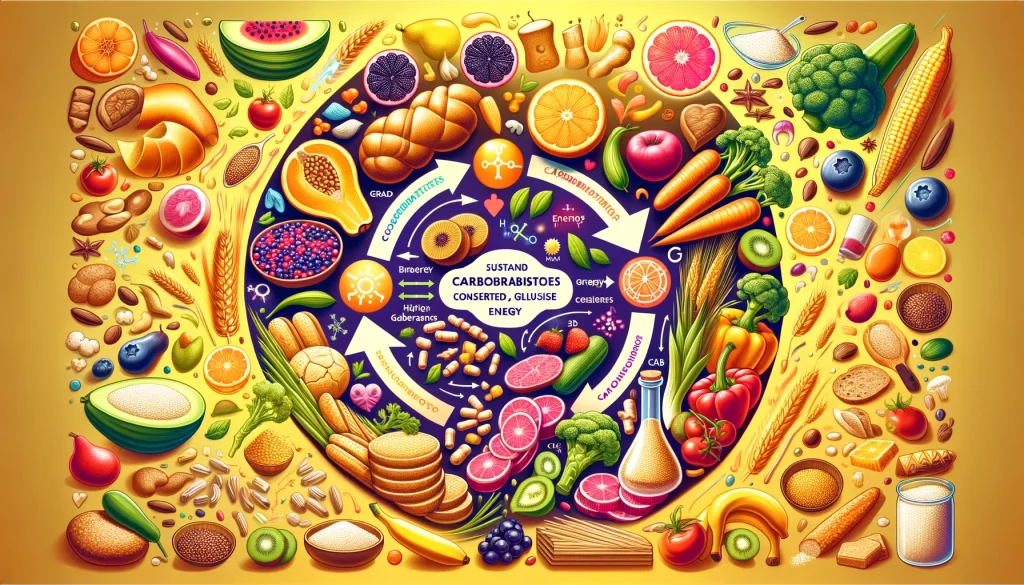
Carbohydrates play several essential roles in human nutrition. Below are the key aspects highlighting their significance:
Primary Energy Source:
- Fuel for the Body: Carbohydrates are the body’s primary energy source. They are easily converted into glucose, which is used by cells, tissues, and organs for energy.
- Brain Function: The brain relies heavily on glucose derived from carbohydrates. Adequate carb intake supports cognitive functions, including memory, attention, and learning.
Regulation of Blood Sugar:
- Glucose in the Blood: Carbs impact blood glucose levels. The type and amount of carbohydrates consumed can influence the speed and magnitude of this impact.
- Glycemic Index (GI): Foods are ranked based on their effect on blood glucose levels. Managing the intake of high-GI foods is essential for blood sugar control, especially for individuals with diabetes.
Digestive Health:
- Fiber Intake: Dietary fiber, a type of indigestible carbohydrate, promotes healthy digestion, prevents constipation, and may reduce the risk of certain gastrointestinal disorders.
- Gut Microbiota: Fibers also serve as prebiotics, feeding beneficial gut bacteria and promoting a balanced and healthy gut microbiome.
Weight Management:
- Satiety: Foods rich in complex carbohydrates and fibers provide a feeling of fullness, helping in appetite control and weight management.
- Energy Density: Whole, unrefined carbs typically have lower energy density, offering fewer calories while still providing essential nutrients.
Heart Health:
- Cholesterol Levels: Soluble fiber found in certain carbs can help lower bad cholesterol levels, potentially reducing the risk of cardiovascular diseases.
- Blood Pressure: A diet rich in whole grains, fruits, and vegetables can contribute to maintaining healthy blood pressure levels.
Physical Performance:
- Endurance: Carbs are vital for athletes and individuals involved in intense physical activities. They provide the energy needed for endurance and performance.
- Recovery: Post-exercise, carbohydrates help replenish glycogen stores in muscles, aiding in recovery and reducing fatigue.
Metabolic Functions:
- Metabolic Pathways: Carbohydrates are involved in various metabolic pathways, ensuring that the body’s biochemical processes function efficiently.
- Synergy with Other Nutrients: They also aid in the metabolism of fats and proteins, ensuring balanced energy production and utilization.
Understanding the role of carbohydrates in human nutrition is pivotal for making informed dietary choices. A balanced intake of diverse carbohydrate sources, especially complex carbs and fibers, is integral to overall health, energy balance, and disease prevention. Each individual’s needs may vary, and factors like age, activity level, and specific health conditions should be considered for personalized nutritional planning.
Nutritional Content of Rice

Rice is a staple food consumed by billions of people around the world. It is a primary source of energy, especially in many Asian countries. Below is an overview of the nutritional content of rice, although it’s important to note that the exact content can vary depending on the type and preparation of the rice.
I. Macronutrients:
A. Carbohydrates:
- Starch: Rice is rich in starch, a complex carbohydrate that provides a steady release of energy.
- Sugars: It contains minimal amounts of naturally occurring sugars.
B. Protein:
- Content: Rice has a modest protein content, with the exact amount depending on the type of rice. White rice has less protein compared to brown or wild rice.
- Quality: The protein in rice is not complete, meaning it lacks some essential amino acids. It’s often paired with beans or lentils to create a complete protein source.
C. Fats:
- Low-Fat: Rice is typically low in fat. Brown rice contains small amounts of healthy fats.
- Fatty Acids: The fats present in brown rice are unsaturated fatty acids which are considered healthy for the heart.
II. Vitamins and Minerals:
A. Vitamins:
- B Vitamins: Rice, especially brown rice, contains B vitamins like B1 (thiamine), B2 (riboflavin), B3 (niacin), and B6 (pyridoxine), essential for energy production and cellular function.
- Vitamin E: Present in small amounts in brown rice, it has antioxidant properties.
B. Minerals:
- Iron: Brown rice provides a source of iron which is crucial for transporting oxygen in the blood.
- Magnesium and Phosphorus: Essential for bone health and various metabolic functions.
III. Fiber:
A. Brown Rice:
- Content: Brown rice is a good source of dietary fiber, beneficial for digestive health.
- Type: It contains both soluble and insoluble fibers.
B. White Rice:
- Refinement: White rice is milled and polished, removing most of the fiber content.
- Enrichment: Some white rice is enriched with iron and B vitamins post-processing.
IV. Glycemic Index (GI):
A. White Rice:
- Higher GI: Tends to have a higher glycemic index, leading to a rapid increase in blood sugar levels.
B. Brown Rice:
- Lower GI: Has a moderate GI due to the presence of fiber and complex carbohydrates, providing a slower release of energy.
The nutritional content of rice makes it a valuable component of a balanced diet. However, moderation and variety are key. Incorporating a mix of whole grains alongside rice, and opting for brown or wild rice when possible, can contribute to a nutritionally rich and balanced diet. The preparation method of rice also influences its nutritional value, so it’s wise to consider cooking practices to retain the most nutrients.
Carbohydrates in Rice
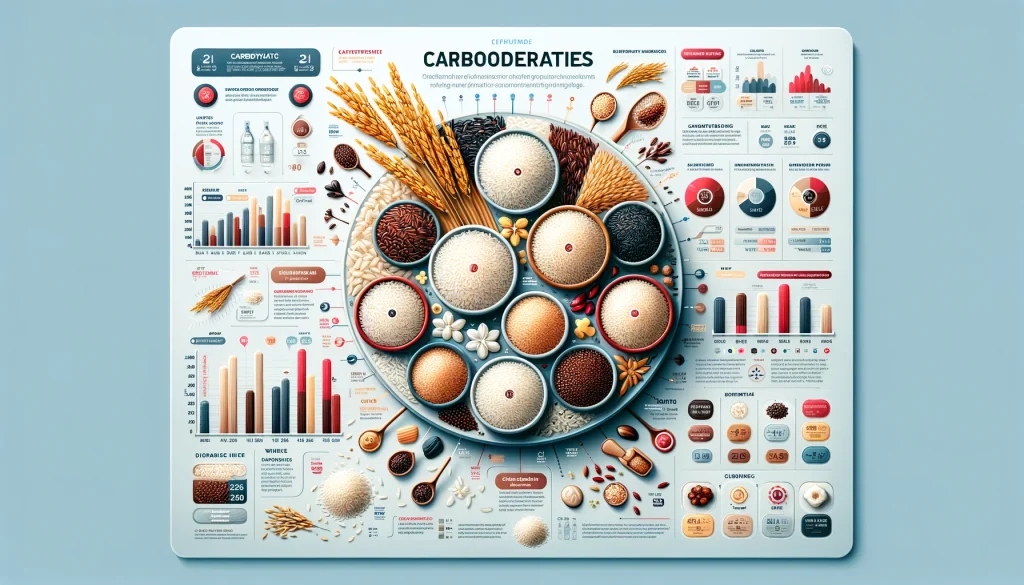
Carbohydrates in Rice: Composition, Digestion, and Health Implications
Rice is primarily composed of carbohydrates, making it a significant energy source for many populations worldwide. This section will detail the types of carbohydrates found in rice, their digestion, and the subsequent impacts on health.
I. Types of Carbohydrates in Rice
- Starch: A predominant carbohydrate in rice, comprising amylose and amylopectin.
- Amylose: A linear, compact structure contributing to the firm texture and lower glycemic index.
- Amylopectin: A branched structure leading to a softer texture and higher glycemic index.
- Sugars: Minimal amounts of naturally occurring sugars.
- Fiber: Present in whole grain varieties like brown and black rice, aiding digestion and lowering the glycemic impact.
II. Digestion and Glycemic Response
- White Rice: Due to lower fiber and higher amylopectin content, it is quickly digested, leading to a rapid spike in blood glucose levels.
- Brown Rice: Contains more fiber and amylose, resulting in a slower digestion and more moderate increase in blood glucose levels.
- Wild and Black Rice: Typically have even higher fiber content and additional phytonutrients, offering a slower glycemic response.
III. Health Impacts
A. Benefits
- Energy Supply: Provides quick energy, making it a staple for physically active populations.
- Versatility: Easy to digest and generally well-tolerated, suitable for varied diets.
B. Concerns
- Blood Sugar Levels: Regular consumption of white rice, particularly in large quantities, may impact blood sugar and insulin levels, potentially increasing the risk of type 2 diabetes.
- Nutrient Deficiency: White rice offers fewer nutrients compared to its whole grain counterparts due to the removal of bran and germ during processing.
IV. Choosing the Right Rice for Balanced Carbohydrate Intake
- Variety: Opt for a mix of rice types to ensure a balanced intake of different carbohydrates, including fibers and resistant starches.
- Portion Control: Moderation is key to prevent excessive calorie and carbohydrate intake.
- Balanced Diet: Pair rice with protein sources, healthy fats, and a variety of vegetables to create a balanced meal with a lower overall glycemic load.
The carbohydrates in rice play a crucial role in providing energy, but the type and quantity consumed should be considered for maintaining optimal health. Whole grain options like brown, black, or wild rice offer additional fiber and nutrients, contributing to a more balanced and healthful carbohydrate intake. Incorporating a diverse range of grains and other carbohydrate sources in the diet can further enhance nutritional adequacy and health outcomes.
Types of Carbohydrates
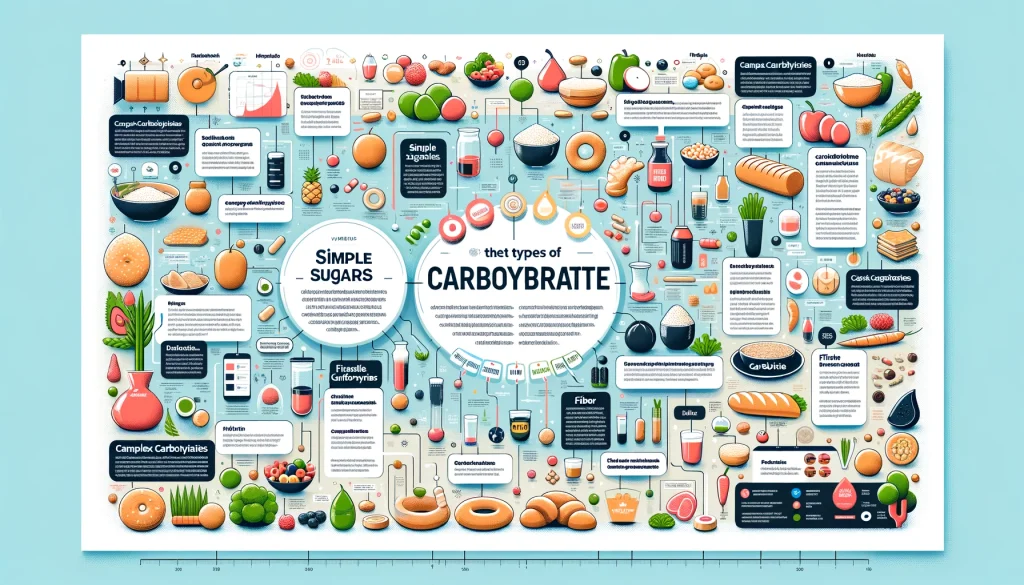
Carbohydrates can be classified into three main categories: monosaccharides, disaccharides, and polysaccharides. Each category has specific characteristics and roles in the body. Here’s a detailed breakdown of each type:
1. Monosaccharides:
Monosaccharides are the simplest form of carbohydrates, consisting of single sugar molecules. They serve as the building blocks for more complex carbohydrates.
Glucose:
- Source: Found in fruits, vegetables, and honey.
- Role: The primary source of energy for the body’s cells. It is absorbed directly into the bloodstream during digestion.
Fructose:
- Source: Present in fruits, root vegetables, and honey.
- Role: Converted into glucose in the liver before it can be used as energy.
Galactose:
- Source: Found in milk and dairy products.
- Role: Similar to fructose, it is converted into glucose in the liver.
2. Disaccharides:
Disaccharides are composed of two monosaccharide molecules. They are broken down into monosaccharides during digestion.
Sucrose (Glucose + Fructose):
- Source: Commonly known as table sugar, found in many plants.
- Role: Provides quick energy upon being broken down into its constituent monosaccharides.
Lactose (Glucose + Galactose):
- Source: Present in milk and dairy products.
- Role: Offers energy and aids in the absorption of calcium and other minerals.
Maltose (Glucose + Glucose):
- Source: Found in malted foods and beverages, and is a product of starch digestion.
- Role: Supplies energy upon being broken down into glucose.
3. Polysaccharides:
Polysaccharides are complex carbohydrates consisting of numerous monosaccharide units. They can be either structural or storage carbohydrates.
Starch:
- Source: Found in grains, legumes, and tubers.
- Role: Serves as a primary storage form of energy in plants, and is a significant source of energy for humans.
Glycogen:
- Source: Stored in the liver and muscles of animals, including humans.
- Role: Acts as a short-term energy storage, quickly converting to glucose when needed.
Cellulose:
- Source: Found in the cell walls of plants, providing structure.
- Role: Indigestible by humans but acts as a dietary fiber, promoting gut health and regular bowel movements.
Functional Roles of Carbohydrates:
- Energy Supply: Provide a rapid source of energy, especially glucose, which powers cellular functions.
- Energy Storage: Stored as glycogen in animals and starch in plants for later use.
- Structural Component: Cellulose and other complex carbs give structural integrity to plants.
- Digestive Health: Dietary fibers (indigestible polysaccharides) support a healthy digestive tract and gut microbiome.
Understanding these types of carbohydrates, their sources, and their roles in the body and diet can assist individuals in making informed dietary choices for balanced energy intake and overall health.
Health Impacts of Carbohydrates
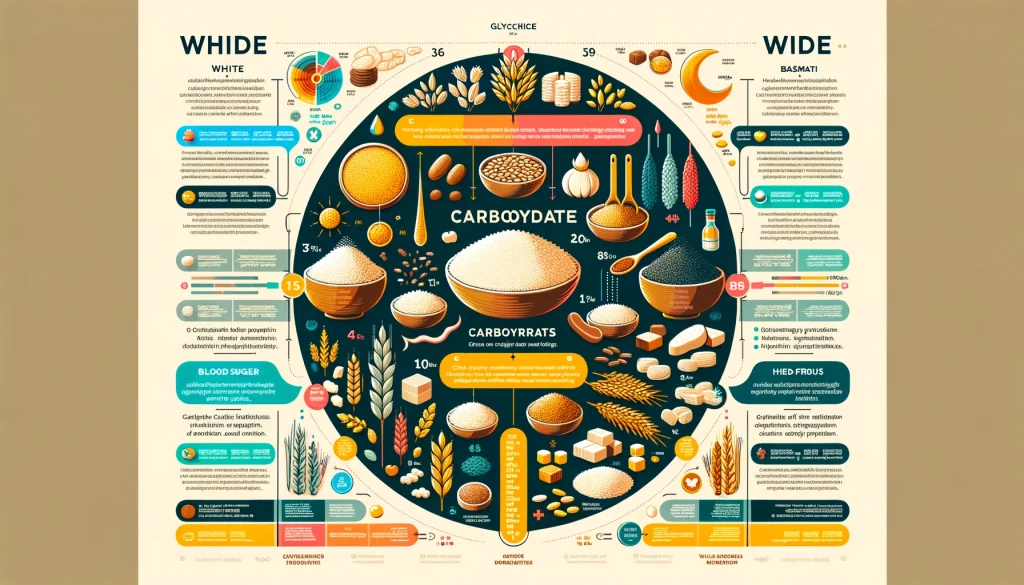
Carbohydrates, as a crucial component of the diet, can have varied health impacts depending on the type, quality, and quantity consumed. Here, we explore both the positive and negative health impacts of carbohydrates.
Positive Health Impacts
- Energy Provision: Carbohydrates serve as the primary source of energy for bodily functions and physical activities. They fuel the brain, muscles, and other organs efficiently.
- Gut Health: Dietary fibers, a type of carbohydrate, promote healthy digestion, prevent constipation, and support a balanced gut microbiome.
- Heart Health: Whole grains and dietary fibers can help reduce bad cholesterol levels, potentially lowering the risk of heart diseases.
- Weight Management: Fiber-rich carbs provide a feeling of fullness, reducing overall food intake and aiding in weight management.
- Cognitive Function: Adequate carbohydrate intake supports optimal brain function, including memory, attention, and learning.
- Blood Sugar Regulation (Complex Carbs): Whole, unrefined carbs have a lower glycemic index, leading to a slower release of glucose and more stable blood sugar levels.
Negative Health Impacts
- Blood Sugar Spikes (Simple Carbs): Refined and simple carbohydrates can lead to rapid spikes and crashes in blood sugar levels, affecting energy and mood.
- Weight Gain: Excessive consumption, especially of refined and sugary carbs, can contribute to weight gain and obesity.
- Dental Health: Sugary carbs can promote tooth decay and other dental issues.
- Increased Risk of Chronic Diseases: Diets high in refined sugars and low in fibers are associated with an increased risk of type 2 diabetes, heart diseases, and certain cancers.
- Digestive Issues: Overconsumption of certain types of carbs, like lactose or fructose, can lead to digestive issues in sensitive individuals.
Mitigating Negative Impacts
- Balanced Intake: Focus on a balanced intake of complex carbohydrates, like whole grains, fruits, and vegetables, and limit refined sugars and processed foods.
- Diversity: Incorporate a variety of carbohydrate sources to obtain a wide range of nutrients and dietary fibers.
- Portion Control: Monitor serving sizes to avoid excessive calorie and carbohydrate intake.
- Lifestyle: Combine a balanced diet with regular physical activity and other healthy lifestyle habits for comprehensive well-being.
The health impacts of carbohydrates are diverse and significantly influenced by the types consumed. A diet rich in complex, fiber-rich, and unrefined carbohydrates is generally associated with positive health outcomes, while excessive intake of refined and sugary carbs can have adverse effects. Individual health, lifestyle, and dietary preferences should be considered to tailor carbohydrate intake for optimal health.
Rice in Dietary Plans
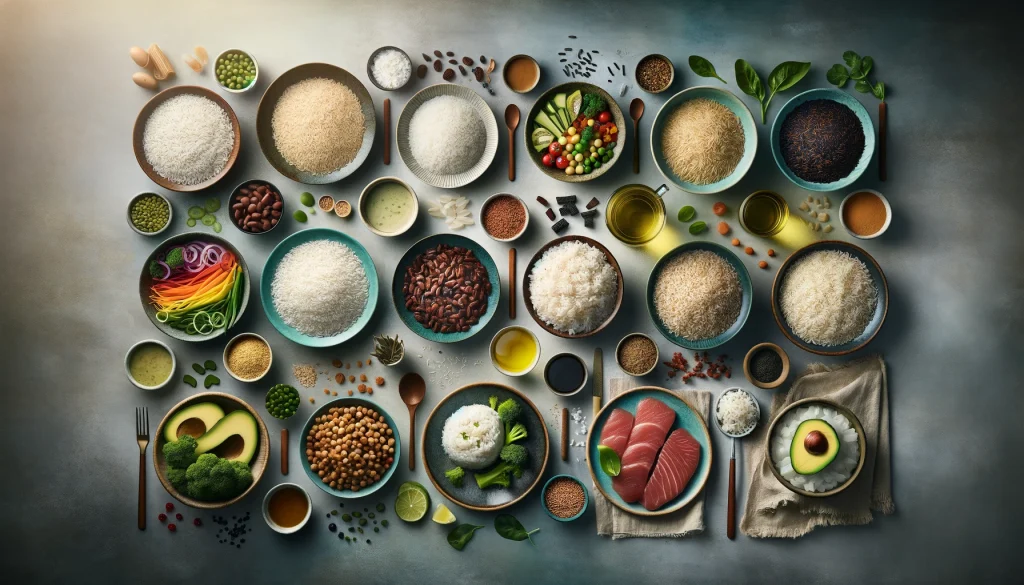
Rice, as a versatile and globally consumed staple, can be incorporated into various dietary plans. However, its type, preparation, and portion size should be considered to align with specific dietary goals and nutritional needs. Below, we explore how rice fits into different dietary frameworks.
I. Low-Carb and Keto Diets:
- Rice Alternatives: Given the high carbohydrate content, white rice is typically avoided. Alternatives like cauliflower rice or broccoli rice can be used as substitutes.
- Portion Control: Small portions of wild or brown rice may occasionally be included, considering their fiber content and net carbs.
- Nutritional Balance: Ensuring adequate intake of proteins and healthy fats to meet energy and nutritional needs.
II. Balanced Diets:
- Whole Grains Preference: Opting for brown, black, or wild rice for their higher fiber, vitamin, and mineral content.
- Serving Sizes: Moderation is key to prevent excessive caloric and carbohydrate intake.
- Combination with Other Foods: Pairing rice with a variety of proteins, fats, and vegetables to create balanced, nutritious meals.
III. Plant-Based Diets:
- Protein Source: While rice isn’t a complete protein, combining it with beans, lentils, or peas can provide all essential amino acids.
- Variety: Incorporating diverse types of rice to ensure a broad spectrum of nutrients.
- Environmental Considerations: Evaluating the sustainability of rice production and opting for eco-friendly options where possible.
IV. Gluten-Free Diets:
- Naturally Gluten-Free: Rice is a go-to option for those avoiding gluten, offering a safe and versatile carbohydrate source.
- Preparation Caution: Being vigilant about cross-contamination with gluten-containing products during preparation and cooking.
- Nutritional Diversification: Combining rice with other gluten-free grains and foods to ensure a nutritionally adequate diet.
V. Weight Loss Diets:
- Caloric Density: Being mindful of portion sizes, as rice is energy-dense and can contribute to higher caloric intake.
- Low-GI Options: Opting for brown or wild rice, which have a lower glycemic index and can aid in blood sugar control.
- Balanced Meals: Including ample vegetables, lean proteins, and healthy fats to enhance satiety and nutritional value.
Rice can be a valuable component in diverse dietary plans, offering energy, essential nutrients, and culinary versatility. The key is to choose the appropriate type of rice, control portions, and consider overall dietary composition for balanced nutrition that aligns with individual health goals, preferences, and dietary restrictions.
Genetic and Agricultural Innovations in Rice Cultivation

The cultivation of rice has been significantly impacted by various genetic and agricultural innovations. These advancements aim to improve rice yield, nutritional content, and sustainability, addressing challenges like climate change, pest resistance, and the nutritional needs of growing global populations.
I. Genetic Innovations:
A. Genetically Modified Rice:
- Golden Rice: Engineered to produce beta-carotene, increasing its nutritional value, particularly Vitamin A content, to combat malnutrition.
- Flood-Resistant Rice: Developed to withstand prolonged submergence, increasing yield in flood-prone areas.
- Pest-Resistant Varieties: Modified to resist specific pests, reducing the need for chemical pesticides.
B. CRISPR and Other Gene-Editing Tools:
- Precision Breeding: Using gene editing to develop rice with desired traits, like drought resistance or improved nutritional profiles, with more accuracy and speed.
- Functional Genomics: Understanding the function of genes to manipulate and enhance particular traits.
II. Agricultural Innovations:
A. Sustainable Farming Practices:
- System of Rice Intensification (SRI): Altering planting, soil, water, and nutrient management to increase yields while reducing water and chemical inputs.
- Integrated Pest Management (IPM): Utilizing biological controls, crop rotation, and other methods to manage pests sustainably.
B. Precision Agriculture:
- Sensor Technologies: Monitoring soil, plant, and environmental variables in real-time to optimize farming practices.
- Drones and Automation: Utilizing drones and automated equipment for planting, monitoring, and harvesting, increasing efficiency.
C. Climate-Smart Agriculture:
- Adaptation Strategies: Developing practices to adapt to climate change impacts, such as changing temperatures and precipitation patterns.
- Carbon Sequestration: Implementing farming practices that capture and store carbon to mitigate greenhouse gas emissions.
III. Future Trends:
- Biotechnology Advancements: Ongoing research to develop rice varieties with enhanced nutritional profiles, yield, and resilience to environmental stresses.
- Data Analytics: Leveraging big data and machine learning to analyze and optimize rice cultivation at an unprecedented scale.
- Resource Efficiency: Innovations aimed at reducing the use of water, fertilizers, and pesticides to make rice cultivation more sustainable.
Genetic and agricultural innovations are crucial in the evolution of rice cultivation, aiming for enhanced yield, nutritional quality, and sustainability. These developments are integral to meeting the dietary needs of the global population while addressing environmental and climate challenges. Collaboration among scientists, farmers, policymakers, and other stakeholders is key to maximizing the benefits of these innovations for food security, health, and the planet.
Cultural Perspectives on Rice and Carbohydrates
Rice and carbohydrates hold different positions of significance and consumption patterns across various cultures worldwide. The role of rice, as a primary source of carbohydrates, can be influenced by geographical, economic, and traditional factors.
I. Asia:
A. Staple Food:
- Predominance: Rice is a cornerstone in the diets of many Asian countries. It is consumed daily and often accompanies every meal.
- Varieties: A plethora of rice varieties, each with distinct flavors, aromas, and textures, are cultivated and cherished.
B. Dietary Patterns:
- Combination with Other Foods: Rice is typically served with vegetables, fish, poultry, or meat, making a balanced meal.
- Fermented Rice Dishes: In some regions, fermented rice dishes are common, offering unique flavors and potential health benefits.
II. Western Countries:
A. Consumption Trends:
- Diversity in Carbs: While rice is popular, there is a wider variety of carbohydrate sources, including bread, pasta, and potatoes.
- Processed Foods: A significant intake of carbohydrates also comes from processed and refined foods.
B. Health Perceptions:
- Low-Carb Diets: There is a growing trend for low-carb and keto diets for weight management and health reasons.
- Whole Grains: An increasing awareness of the health benefits of whole grains, leading to a rise in the consumption of brown and wild rice.
III. Africa:
A. Rice in Diets:
- Staple in Some Regions: Especially in West Africa, rice is a staple, while in other regions, maize and other grains might predominate.
- Import Dependency: Some countries rely on imported rice to meet the demand.
B. Traditional Dishes:
- Jollof Rice: A popular dish in West Africa, showcasing the cultural significance of rice.
- Rice Mixtures: Often mixed with spices, vegetables, and proteins to create flavorful, nutritious meals.
IV. Latin America:
A. Consumption Patterns:
- Rice and Beans: A classic combination, offering a complete protein source and balanced nutrition.
- Varieties: Preference for long-grain white rice in many dishes.
B. Nutritional Aspects:
- Balanced Meals: Rice is part of a varied diet, combined with abundant vegetables, legumes, and meats.
- Street Food: Rice is often included in popular street food options, reflecting its cultural ubiquity.
Cultural perspectives on rice and carbohydrates are diverse, shaped by historical, agricultural, and culinary contexts. From being a staple food in Asia to the dynamic consumption patterns in the West and other regions, rice plays a multifaceted role globally. Understanding these cultural nuances is crucial for global food policy, nutrition education, and the promotion of balanced, sustainable diets worldwide.
Future Trends in Rice and Carbohydrate Consumption
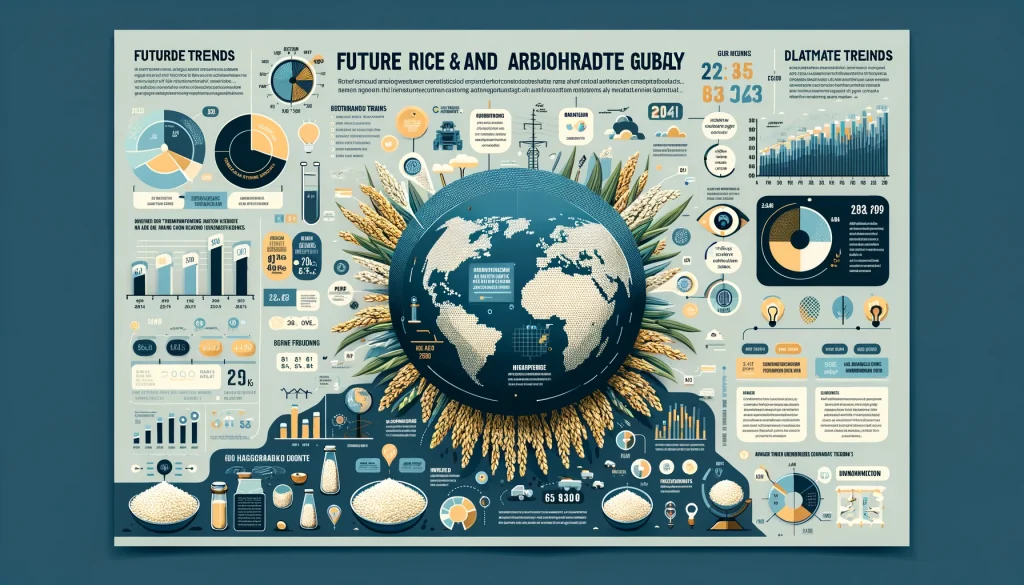
As the global population continues to grow and the impacts of climate change become more pronounced, significant changes are anticipated in the production, consumption, and perception of rice and other carbohydrate sources. Here are some expected future trends:
I. Rice Consumption:
A. Demand Increase:
- Population Growth: The global population increase, especially in Asia, is expected to boost rice demand.
- Urbanization: Shifts in dietary preferences with increasing urbanization may influence rice consumption patterns.
B. Diversification:
- Culinary Innovations: A variety of rice-based dishes and products emerging globally.
- Health Awareness: A surge in brown, black, and red rice consumption due to heightened health and nutritional awareness.
II. Nutritional Science:
A. Nutritional Enhancement:
- Biofortification: Advances in technology to enhance the nutritional content of rice, like Golden Rice.
- Dietary Shifts: Increasing awareness of balanced diets may lead to diversified carbohydrate consumption.
B. Personalized Nutrition:
- Custom Diets: Data-driven personalized diet plans could influence individual preferences for rice and other carbs.
- Genetic Insights: Understanding genetic responses to different carbs for personalized nutrition.
III. Sustainability and Agriculture:
A. Climate-Resilient Varieties:
- Genetic Engineering: Development of rice varieties that are resistant to drought, flooding, and salinity.
- Agricultural Practices: Adoption of sustainable and efficient farming practices to enhance yield and reduce environmental impact.
B. Technology Integration:
- AI and Machine Learning: Use of advanced technologies to optimize rice cultivation, processing, and distribution.
- Precision Agriculture: More widespread adoption for resource optimization and yield maximization.
IV. Global Trade and Policy:
A. Trade Dynamics:
- Global Policies: Evolution of policies affecting international rice trade.
- Local Production: Encouragement of local production to reduce dependency on imports in some regions.
B. Food Security:
- Strategic Reserves: Nations may enhance strategic reserves to counteract price volatility and ensure food security.
- Diversification: Strategies to diversify carbohydrate sources for resilience against crop failures or trade disruptions.
V. Consumer Preferences:
A. Health Trends:
- Low-Carb Diets: The continuation or evolution of trends like keto, paleo, or low-glycemic diets impacting rice consumption.
- Whole Foods: An increasing shift towards whole, unprocessed carbohydrate sources for health benefits.
B. Ethical and Environmental Choices:
- Sustainable Options: Rising consumer demand for environmentally friendly and ethically produced rice.
- Label Awareness: Increased attention to labels, seeking non-GMO, organic, and fair-trade options.
The future of rice and carbohydrate consumption is expected to be shaped by factors like technological innovations, climate change, global policy, and shifting consumer preferences. Adaptations in agricultural practices, advancements in nutritional science, and evolving consumer awareness will collectively influence the role of rice and other carbohydrates in global diets, economy, and food security. The integration of sustainability, technology, and nutrition will be pivotal to meet the challenges and opportunities ahead.
Frequently Asked Questions (FAQ)

Q: What are carbohydrates?
A: Carbohydrates are organic compounds made up of carbon, hydrogen, and oxygen. They are a primary energy source for the body, classified into monosaccharides, disaccharides, and polysaccharides, based on their molecular structure.
Q: Are all carbohydrates bad for your health?
A: No, not all carbohydrates are bad. Whole, unprocessed carbs like fruits, vegetables, and whole grains are nutrient-dense and beneficial for health. It’s the refined and processed carbs, like sugar-sweetened beverages and pastries, that should be limited.
Q: How do carbohydrates affect blood sugar?
A: Carbohydrates are broken down into glucose (sugar) in the body, leading to a rise in blood sugar levels. The type and amount of carbs, their fiber content, and the food’s glycemic index influence the speed and magnitude of this increase.
Q: What is the glycemic index (GI)?
A: The glycemic index measures how quickly a food containing carbohydrates raises blood glucose levels. Foods with a low GI are absorbed more slowly, resulting in a gradual increase in blood sugar levels.
Q: Can I lose weight while eating carbohydrates?
A: Yes, weight loss can be achieved with a balanced diet that includes carbohydrates. The key is to focus on whole, unprocessed carb sources, control portion sizes, and ensure an overall balanced diet and active lifestyle.
Q: What are “net carbs”?
A: Net carbs are the total carbohydrates in a food minus its fiber content. They represent the carbs that are digestible and can affect blood sugar levels.
Q: Are fruits bad because of their sugar content?
A: Fruits, although they contain natural sugars, are a healthy choice because they also provide essential nutrients, including vitamins, minerals, and dietary fiber. The fiber in fruits helps moderate blood sugar response.
Q: Is a low-carb diet suitable for everyone?
A: Individual responses to low-carb diets can vary. While some people may benefit from reduced carb intake, others may not. It’s essential to consider personal health status, activity levels, and specific dietary needs.
Q: Why are whole grains better than refined grains?
A: Whole grains retain all parts of the grain—bran, germ, and endosperm—providing more fiber, protein, and other nutrients. Refined grains are processed, removing the bran and germ, leading to a loss in nutritional content.
Q: How can I include more healthy carbohydrates in my diet?
A: Opt for whole grains, consume a variety of fruits and vegetables, include legumes and pulses, and minimize the intake of processed and sugary foods and beverages.
Q: How do different types of carbohydrates interact with the body’s metabolic processes?
A: Different types of carbohydrates, such as simple sugars, complex starches, and fibers, are metabolized at varied rates. Simple sugars are rapidly absorbed, causing a quick rise in blood glucose, while complex carbohydrates and fibers are digested more slowly, leading to a gradual increase in blood sugar. Fibers are partially or completely indigestible and contribute to gut health, cholesterol regulation, and overall digestion.
Q: What role do carbohydrates play in hormonal regulation, specifically insulin and glucagon?
A: Carbohydrates directly influence insulin and glucagon secretion. Consuming carbs leads to an increase in blood glucose levels, triggering insulin release to facilitate glucose uptake into cells. In contrast, lower blood glucose stimulates glucagon release, promoting glycogen breakdown and glucose release into the bloodstream to maintain energy balance.
Q: Can a diet high in refined carbohydrates influence gut microbiota composition?
A: Yes, a diet high in refined carbohydrates can lead to an imbalance in gut microbiota. It can promote the growth of opportunistic pathogens and reduce the abundance of beneficial bacteria, potentially leading to digestive issues, inflammation, and increased vulnerability to various health conditions.
Q: How does the structural configuration of carbohydrates, like alpha and beta bonds, impact their digestibility and functionality?
A: Alpha bonds, found in starches like amylose and amylopectin, are easily broken down by human digestive enzymes. In contrast, beta bonds, found in cellulose (a form of fiber), are indigestible, contributing to cellulose’s role as a fiber that aids in digestion, adds bulk to stool, and supports gut health.
Q: What are the implications of chronic high-carbohydrate diets on insulin sensitivity and metabolic health?
A: Chronic high intake of especially refined carbohydrates can lead to increased insulin secretion, potentially resulting in insulin resistance over time. This can elevate the risk for metabolic syndrome, type 2 diabetes, and other metabolic disorders characterized by impaired glucose regulation, lipid metabolism, and increased inflammation.
Q: How can the Maillard reaction in carbohydrate-rich foods impact their nutritional quality and safety?
A: The Maillard reaction occurs between amino acids and reducing sugars during cooking or processing, leading to browning and flavor development. While it can enhance flavor, it can also reduce nutritional value and produce advanced glycation end products (AGEs), which have been associated with increased oxidative stress and inflammation.
Q: Are low-glycemic index (GI) carbohydrates always a healthier option? Are there exceptions?
A: Low-GI carbohydrates are often healthier as they cause a slower, more gradual increase in blood glucose. However, the GI is not the sole determinant of a food’s nutritional value. Some low-GI foods can be nutrient-poor, and some high-GI foods (like fruits) can be nutrient-rich.
Q: How do carbohydrates contribute to the body’s antioxidant defense mechanisms?
A: Some carbohydrates, particularly those in fruits, vegetables, and whole grains, come packaged with various antioxidants like vitamins C and E, selenium, and phytochemicals. These can neutralize free radicals, reduce oxidative stress, and lower the risk of chronic diseases.
Q: Can you elaborate on the emerging research regarding carbohydrates and their impact on cognitive health?
A: Emerging research suggests a connection between carbohydrate quality and cognitive health. Diets rich in whole, unprocessed carbohydrates have been linked to reduced risks of cognitive decline and neurodegenerative diseases, while diets high in refined sugars and simple carbs may be associated with impaired cognitive function and memory.
Q: How is ongoing climate change expected to impact the carbohydrate content and quality in staple crops like rice and wheat?
A: Climate change, characterized by increased temperatures, changing precipitation patterns, and extreme weather events, can impact crop yields, carbohydrate content, and quality. Potential effects include altered starch compositions, reduced nutrient content, and changes in protein and mineral levels, affecting the overall nutritional quality of staple crops.
These answers can provide in-depth insights and understanding for individuals, nutritionists, dietitians, or researchers looking for expert-level information on carbohydrates and their various aspects in health and nutrition.
Conclusion
As we navigate through the labyrinth of information, misconceptions, and genuine insights surrounding carbohydrates, a balanced perspective emerges, underscoring the importance of these macronutrients, yet advocating for discernment in their sources and consumption. Carbohydrates, in their myriad forms, are not merely sources of energy but contributors to a nuanced interplay of metabolic processes, gut health, and disease prevention or proliferation.
Our exploration underscores a significant realization – not all carbohydrates are created equal. The contrast between the refined sugars saturating processed foods and the complex carbohydrates gracing whole, unprocessed foods is stark. While the former often leads to rapid glucose spikes, potential insulin resistance, and an array of health challenges, the latter offers sustained energy, metabolic balance, and a contribution to overall well-being.
Rice, a global staple, exemplifies this complexity. Its various types, from white to brown, black, and red, offer distinct nutritional profiles, glycemic indices, and health impacts. Genetic and agricultural innovations continue to shape rice’s future, striving for enhanced nutritional value, climate resilience, and sustainability. Cultural preferences and dietary patterns, interwoven with economic and environmental factors, influence rice consumption, attesting to its integral role in global food systems.
As we step into the future, informed choices become paramount. The burgeoning field of personalized nutrition, underscored by technological and scientific advancements, promises tailored dietary recommendations, aligning carbohydrate sources and quantities with individual metabolic responses, health statuses, and lifestyle factors. Sustainability, too, emerges as a pivotal consideration, urging a harmonization of dietary choices with ecological preservation.
In essence, carbohydrates, often caught in the crossfire of nutritional debates, reclaim their place as vital, yet complex, components of the diet. Their balanced consumption, rooted in an understanding of their types, sources, and impacts, can pave the path to enhanced health, vitality, and longevity. As consumers, the onus rests upon us to transcend generalized narratives, embrace nuanced understanding, and make informed choices that harmonize our well-being with the planetary health. In this balanced approach, carbohydrates are neither villains nor panaceas but integral elements within the diverse mosaic of nutrition.
References:






